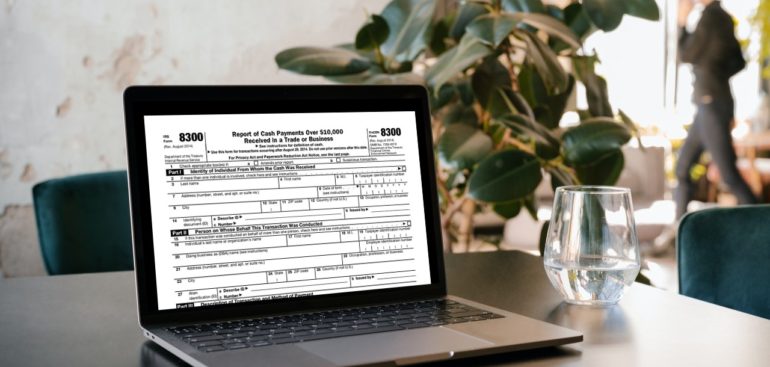The various Internal Revenue Service tax forms can be hard to differentiate at times. A 1040 is simple, and so is filing 1099 for small businesses. But what is the IRS form 8300?
Making money and living the good life is what anyone wants. But paying taxes comes with that dream as well, as it should. With every paycheck, cash payment or deposit, there comes a percentage that goes to Uncle Sam, and we know this. Being able to understand the various tax forms is important to individuals and businesses alike. One of the lesser-known forms may be the IRS form 8300.
Filing tax forms can be simple for a great number of us, but for those who are indeed less familiar, tax preparation businesses, both in-person and online, can do the hard work for us. As for the tax forms that aren’t discussed as often as most, the IRS form 8300, for instance, If you’re like many other individuals who insist on preparing their own returns, an explanation can help you understand the process with this form as well.
What is the purpose of IRS form 8300?
Almost 200,000 IRS form 8300s were filed in the year 2011 and kept in the treasury department records. Since then, this number has grown quite a bit. There’s a detailed purpose for the IRS form 8300 that helps both the government and the rest of us stay in business, per say.
In fact, there are factors involved that prove this form has different meanings from person to person. Basically, the IRS form 8300 is used for cash transactions, whether made by tradesmen, businesses, or individuals. The purpose – to ensure that all money owed to the government is attained.
Simply put, if you receive more than $10,000 in cash at one time, or in related transactions, these cash payments must be filed on the 8300 form. This is a necessary way of keeping up with cash payments, much different than easily documenting W2s derived from paychecks, or small business 1099s. With the 8300 form, even cash payments can be traced, documented, and then filed away in archives.
What counts as cash on the 8300 form?
Cash is simply stated – currency- whether foreign or domestic. However, some transactions that appear to be cash exchanges are not really counted as such. Wire transfers don’t have to be reported on the 8300 form because they’re not considered cash, but digital transactions instead. The following forms of payment are considered cash tender that must be reported when acquired in sums of more than $10,000.
- Bank drafts – Any consistent payment drawn from a bank account and used to make a payment is not considered the same as cash.
- Traveler’s check – This form of payment is acquired at the bank, used mostly for going on vacations. They resemble tickets or large paper bills.
- Cashier’s check – This form of payment can be used in the place of hard currency, usually a check drawn by the bank instead of an individual.
- Money orders – this form of payment is used primarily through mail orders when sending cash isn’t safe. You can purchase these with the postal service and other establishments.
Who’s exempt from filing an 8300 form?
There are those that are exempt from filing an 8300 form with the IRS. Any charity organizations that are non-taxable aren’t subject to completing the form, even when making over $10,000 in cash. But, if the same organization conducts a separate business deal, that’s another story.
For instance, if a university or hospital receives a donation, a form isn’t needed. On the other hand, university tuition of over $10,000 is required to be filed on the 8300 form, as well as emergency care costs at the hospital. It’s a set of factors that make the difference in whether you file or do not.
The internal revenue service requires this valuable information, but they’re not the only ones. The Financial Crimes Enforcement Network or the “FinCEN” monitors “cash money makers” to prevent money laundering. And what is money laundering? Well, it’s the very thing that finances even more illegal activity like drug trafficking, terrorism and even tax evasion.
Who must file the IRS 8300 form?
Many people must file the IRS form 8300 including Corporations, companies, estates, partnerships, trusts, associations, and even individuals. And this form must be filed by any of these entities residing in the United States, including Puerto Rico and the island territories.
There are many types of transactions which generally fall under this category. These are generally large one-time payments or payments split into two or three installments but within a small-time frame. Here are a few examples.
- Car purchases from used car dealers can be reported on the 8300 form, as some used automobiles purchased in this manner cost over $10,000. Although a great number of these automobiles are much cheaper, there are still exceptions, and these purchases must be reported.
- Taxi companies must file an 8300 form when a taxi driver leases a vehicle for over $10,000 and uses cash to do so. If another vehicle is also purchased for the same amount with cash, the company must fill out an additional form.
- Universities and other college institutions must fill out IRS form 8300 when more than $10,000 is received in cash from a student or anyone else, pertaining to the institution or education there within.
- During a 12-month period, if a landlord receives cash payments of over $10,000 in rent, they must also report this on an 8300 form.
- Contractors file payments of more than $10,000 on the IRS form 8300 when completing any job including painting, construction etc.
- Bail bondsmen also report any payments above 10,000 during an arrest or when expecting an arrest. Even if nothing happens, once the money is received, it must be reported within 15 days.
- Any cannabis sales, or marijuana related businesses must also report payments of over 10,000 for purchases from dispensaries or other avenues of legal business.
What happens if an IRS form 8300 is filed on you?
If an IRS form 8300 is filed on you, then you will receive a statement of the transaction for your own filing responsibilities. You must provide a TIN number when making cash payments over $10,000 because this will be needed by the company, individual or so forth to file the 8300 form.
You will receive all information about the business or individual such as name, address, phone number and type of transaction. This cash exchange can be in whole or part if made within a short period of time. Either way, attaining your taxpayer identification number is the only way the 8300 form can be completed. And according to law penalties come with failure to comply.
When making a cash purchase it’s usually better to provide the taxpayer identification number up front to prevent confusion or waste time later. Considering you were part of the transaction; you will have to provide this information to complete tax preparation for both parties. A copy of the 8300 form must be provided to the other party by January 31st of the following year.
When must form 8300 be filed?
You may want to put off filing the 8300, but that wouldn’t be wise. This IRS form must be completed 15 days after the transaction. More so, including all pertinent information is mandatory. This means, for every name listed on the 8300 form, a written statement must be provided to them. And these statements must be completed by January 1st of the following year.
Included on the statements, you must list your name, company name, address, phone number, and the amount of cash that was exchanged. On the statement, you must also include the fact that this same information has indeed be reported to the IRS. In other words, all parties must be in the know. If you fail to provide these statements and report cash exchanges to the IRS, penalties will ensue. These charges change from year to year.
The IRS and your form 8300
When you file an IRS form 8300, it’s then archived with the rest of your business documents that are tax related. The IRS retains these forms to ensure your business is reporting all transactions and being honest. It’s a good idea to keep a copy of every IRS form 8300 for your own records in case there are any disputes.
Penalties for failure to file
Although IRS penalties can be steep, simply failing to file an 8300 form carries a fine that’s a little more lenient. For each occurrence, the penalty is only $100, and if you make under 5 million, the absolute maximum penalty that you pay is $500,000, but if you correct the failure to file within 30 days, you pay no more than $75,000.
The bottom line
In a nutshell, the IRS form 8300 is a mandatory form for all individuals, businesses and other organizations when making cash transactions. It is highly recommended that any of these entities ensure all forms, including this one to be completed to avoid problems with both the IRS and the FinCEN. It’s just about making smart choices, and doing business with a clear conscious.




